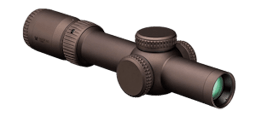
OPTICS
Optics for sale
View
Shop Optics for Firearms — Scopes, Sights, Binoculars & More
At DEGuns, we offer a premier selection of firearm optics to help you shoot farther, aim faster, and hunt smarter. Whether you're a weekend hunter, tactical shooter, or long-range competitor, the right optic can make all the difference. From cutting-edge rifle scopes and red dot sights to rugged binoculars, thermal vision optics, and essential mounting hardware, you’ll find top-rated optics from trusted names like Vortex, Leupold, Swampfox, Nightforce, and more.
Our lineup rivals other top retailers like Optics Planet and Primary Arms — but we aim to give you more: better pricing, expert support, and a no-nonsense shopping experience.
Types of Firearm Optics
1. Rifle Scopes
Rifle scopes are a must-have for hunters and precision shooters. These optics help you dial in accuracy at longer ranges, with variable magnification settings, crystal-clear lenses, and reticles tailored to different use cases — whether you’re stalking deer in dense woods or punching steel plates at 1,000 yards.
When shopping for rifle scopes, consider:
- Magnification: Fixed or variable? A 3-9x scope is perfect for hunting, while 5-25x is better suited for long-range shooting.
- Objective Lens Size: Larger lenses collect more light and improve clarity in low-light environments.
- Reticle Type: Choose from illuminated, BDC (bullet drop compensator), MOA, or MIL-dot reticles based on your shooting needs.
- Eye Relief: Especially critical for heavy-recoiling calibers.
- Turrets & Adjustments: Precision shooters need easy windage and elevation controls with audible/tactile feedback.
2. Red Dot Sights
Red dot sights are ideal for rapid target acquisition in close to mid-range environments. Unlike rifle scopes, red dots do not magnify your target. Instead, they project a bright reticle (typically a red or green dot) directly onto a lens for quick aiming with both eyes open — a huge advantage in tactical and defensive shooting scenarios.
Types include:
- Standard Red Dots: Compact and low-profile, perfect for AR-15 platforms, pistols, and shotguns.
- Reflex Sights: Open-frame design, great for fast shooting and broad peripheral vision.
- Holographic Sights: Advanced reticles and better performance in bright light, but often more expensive.
3. Magnifiers
A red dot magnifier gives you the best of both worlds — speed from your red dot and enhanced accuracy when you need it. These optics usually mount behind your red dot and flip to the side when not in use.
Common features include:
- 3x Magnification: Standard across most models.
- Quick-detach Mounts: Easily remove or adjust without tools.
- Flip-to-Side Designs: Instantly switch between magnified and unmagnified views.
4. Binoculars
Binoculars are essential for scouting, spotting, and wildlife observation. DEGuns stocks hunting binoculars that are compact, waterproof, and high-powered for backcountry expeditions and range work alike.
Key features to look for:
- Magnification / Objective Lens Size: 10x42 is a popular all-around configuration.
- Field of View: A wider view lets you scan terrain faster.
- Low-Light Performance: Look for multi-coated lenses and high-quality glass.
5. Monoculars
Need something more compact than binoculars? Monoculars offer one-eye viewing and are lightweight enough to carry in your pocket. These optics are excellent for quick spotting, navigation, or scanning terrain when weight matters.
Ideal for:
- Minimalist Hunters
- Tactical Field Use
- Backup Spotting Tool
6. Rangefinders
When you need to know the exact distance to your target, a laser rangefinder is the tool for the job. Rangefinders take the guesswork out of long-range shooting by calculating distance, angle, and often ballistic drop.
Look for:
- Laser Accuracy: To 1,000+ yards
- Angle Compensation (ARC)
- Ballistic Modes for different calibers
- Compact Design with Weatherproofing
7. Rings & Mounts
Your optics are only as reliable as the mount holding them. We carry rings, bases, and cantilever mounts designed for AR platforms, bolt-action rifles, shotguns, and handguns.
Mounting options include:
- Picatinny / Weaver Mounts for modular setups
- QD (Quick Detach) Systems
- One-Piece Scope Mounts for maximum alignment and strength
- Lightweight Aluminum or Steel Options
Thermal Optics & Night Vision Scopes
DEGuns also offers night vision and thermal optics for those who hunt or operate after dark. Whether you're scanning for hogs in total darkness or watching a field at dawn, these advanced optics use infrared or thermal heat signatures to highlight targets that would otherwise be invisible.
Types include:
- Thermal Scopes: Detect heat signatures through dense brush or at night.
- Night Vision Goggles: Tactical head-mounted setups.
- Clip-On Thermal Adapters: Add thermal capability to your day scope.
- Hybrid Scopes: Combine daytime and night vision functionality.
How to Choose the Right Optic for Your Needs
With so many options, choosing the right optic depends on your application:
| Use Case | Recommended Optics |
|---|---|
| Home Defense | Red Dot Sight, Holographic Sight |
| Deer Hunting | Variable Zoom Scope (3-9x or 4-12x) |
| Long-Range Shooting | 5-25x Scope, Rangefinder |
| Tactical Use | Red Dot + Magnifier, Thermal Optic |
| Backcountry Scouting | Binoculars, Rangefinder, Monocular |
| Night Hunting | Thermal Scope, Night Vision Scope |
A Look Back: The Evolution of Rifle Optics
Rifle optics have come a long way since their humble beginnings over 300 years ago. The idea of mounting a magnified lens to a firearm dates back to the 18th century, but it wasn’t until the 1850s that optics like the Malcolm scope began making rifles significantly more accurate.
By WWI, German snipers were dominating trench warfare with early Zeiss scopes. American designs like the Lyman Alaskan followed. During the Vietnam War, legendary sniper Carlos Hathcock famously attached a scope to a .50 cal machine gun — achieving one of the longest sniper kills in history. That ingenuity helped spark innovations that now benefit today’s hunters and sportsmen.
Today, modern scopes boast rugged construction, illuminated reticles, ballistic calculators, and low-light glass clarity that early shooters could never have imagined.
Top Optics Brands Available at DEGuns
We’re proud to carry optics from industry-leading brands known for performance, value, and innovation:
- Vortex Optics: Rifle scopes, red dot sights, binoculars, and rangefinders with a VIP lifetime warranty.
- Leupold: Premium American-made scopes and spotting gear with military-grade durability.
- Swampfox: Tactical optics built for real-world abuse, with competitive pricing and cutting-edge features.
- Nightforce: High-end scopes for precision shooters, trusted by elite military units and competition marksmen.
Shop Firearm Optics with Confidence
DEGuns is your go-to source for red dots, scopes, spotting optics, and night vision gear. With fast shipping, competitive pricing, and expert support, we help shooters at every level find the right optic for their mission. Whether you're mounting your first red dot or upgrading to a tactical scope, we’ve got the gear to help you hit your target — every time.
Explore our full collection of optics and firearm accessories today to get dialed in and ready for the next shot.










